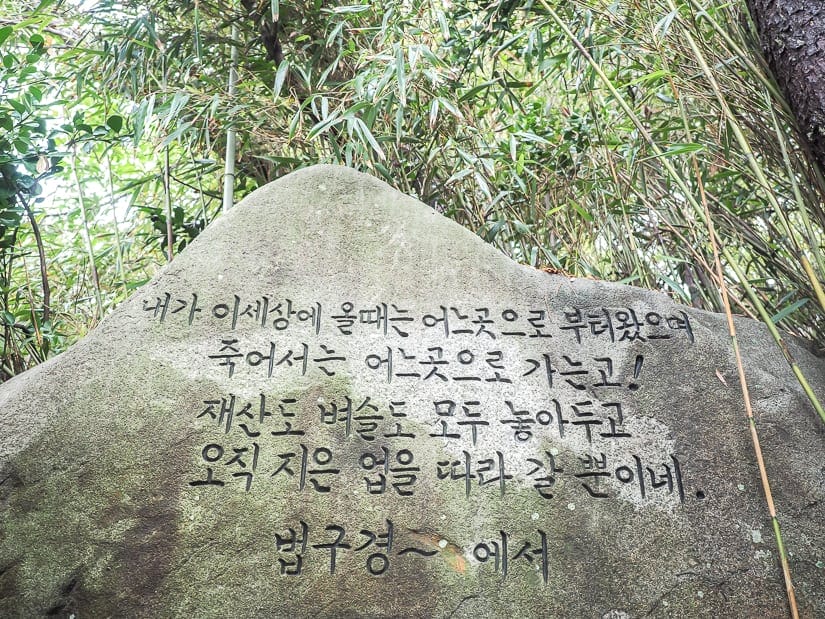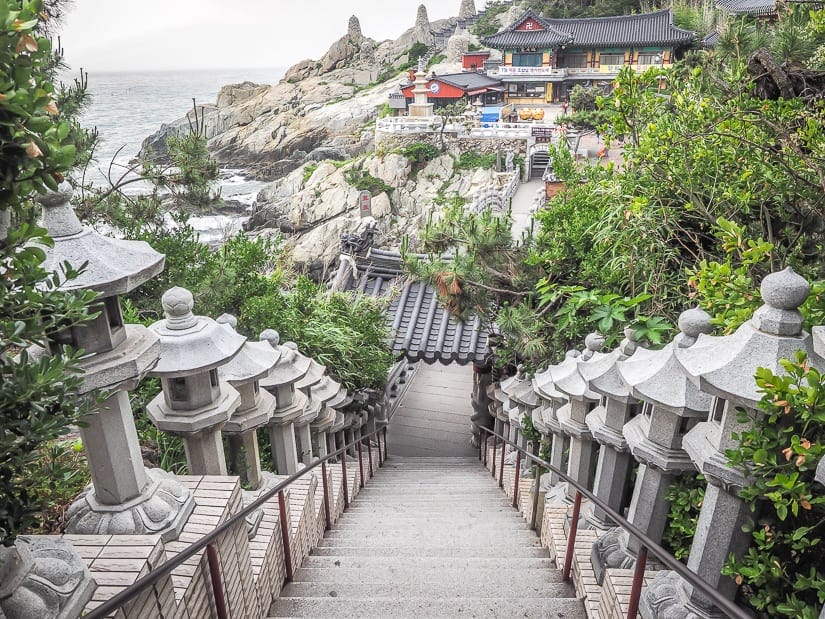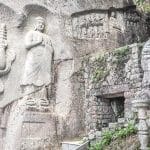Dear reader: This article contains links to products and services that I may be compensated for, at no extra cost to you.
Haedong Yonggunsa, or Haedong Yonggung Temple, is one of the most impressive Buddhist temples in South Korea. It is without a doubt one of Busan’s top temples and makes my list of top 50 things to do in Busan.
Haedong Yonggungsa is famous for its picturesque seaside location. Busan’s “Temple on the Coast” is also a hot spot for watching the sunrise on the first day of the year or, increasingly, any day of the year, making it one of the most popular day trips from Busan.
The temple is also an especially popular spot when the cherry blossoms bloom around April, and on the Buddha’s birthday, when it is decorated with hundreds of paper lanterns (for the best temple in Busan to witness the Lantern Festival, see my article on Samgwangsa.)
Of all the temples I’ve been to in Busan, Haedong Yonggungsa is the one I had the highest expectations for, but also the only one I left feeling I wasn’t sure whether I actually liked it. I had similar feelings about (but was still really glad I visited) Gamcheon Culture Village, the super colorful arts village in Busan.
Below I’ll explain why I had these mixed feelings, so you can decide whether to include it on your Busan itinerary or not. I’ll also cover the history of the temple, what you can expect to see there, tips to improve your experience, how to get to Haedong Yonggungsa, and how to see the sunrise there like I did.
Sea lovers should also check out my guide to beautiful Taejongdae Resort Park on the south Busan coast!
Tips for Visiting Haedong Yonggungsa
– Save time getting there by hiring a private driver, with a ₩3833 discount if you sign up for Klook using this link first, applicable to any activity of Klook.
– See the temple as a part of this East Coast Busan tour, this full city tour, or this photography focused tour.
– Get there early to avoid the crowds (opening hours are 5 a.m. to 7 p.m.)
– Seeing the sunrise there is a popular thing to do. For convenience, considering staying within walking distance of the temple, such as this nearby guesthouse.
Table of Contents
History of Haedong Yonggungsa

While Haedong’s Yonggungsa’s rise to fame among tourists is a relatively recent thing, the temple has a long history going all the way back to 1376, during the Goryeo Dynasty, when it was built by the great Buddhist teacher Naong Hyegeun.
The temple was originally called Bomun Temple and was dedicated to Gwanseum-bosal, the Goddess of Compassion, whose large statue you can see there today (the white statue in the photo above).
Bomun temple was partially destroyed in a fire during the Japanese invasion of Korea from 1592 to 1598, and then abandoned. Some of what can be seen today dates to the 1930s, when the temple was reestablished by monks from Tongdosa, and a lot of it has been added in the last 20 years and looks very new.
It wasn’t until 1974 that Bomun Temple was renamed Haedong Yonggungsa, which means “Korean Dragon Palace Temple.” The name comes from a vision experienced by Jeong-am, the head monk at the time, of the Goddess of Mercy riding a dragon, during meditation.
Also check out this Busan temple carved into cliffs and this coastal park with another beautiful temple.
Location and Layout of Haedong Yonggungsa

Haedong Yonggungsa is in Gijang-gun (Gijang county) on the northeast coast of Busan city, six kilometers northeast of Haeundae, the city’s most famous beach.
The temple occupies the northern side of a rocky peninsula between lesser-known Songjeong Beach and a small fishing village to the south, and the National Fisheries Science Museum and ultra-luxurious Ananti Hilton Busan (see on Agoda / Booking / Klook / TripAdvisor) to the north.

Arriving by bus or by car, visitors follow a narrow road downhill past a multiple food and souvenir stalls (see my thoughts on that below…) to reach the temple entrance. The first signs of a temple are a row of 12 larger-than-human-sized zodiac animals and various other statues and carved stones.
At the end of the row of statues, there’s a towering 7-story pagoda, at the base of which sits a car wheel shrine, where people can pray to avoid car accidents.
If you are currently planning your trip to Busan, be sure to also see my article on where to stay in Busan (including hotels near Haedong Yonggungsa), and this review of my favorite hotel in Busan!


From this point, visitors can descend a flight of stone stairs to reach the sunrise platform and western side of the temple ground, or continue straight down a narrow vehicle road to reach the Gwanseeum-bosal statue on eastern side of the temple grounds.
The stone stairs (of which there are 108, an auspicious number in Buddhism) descend into a small bamboo forest and are lined with stone lanterns and other carvings, including a fat Podae-hwasang (an incarnation of Mireuk-bul, the Future Buddha, known as Maitreya or Milefo in Chinese Buddhism), whose belly you can rub.


Just after the five “statues of Buddha for academic achievement” a sign with the Chinese characters for sunrise (日出) points to the left for the sunrise platform, while the stairs continue downward to a stone bridge providing access to the main temple area. Many guests like to toss coins into stone ponds below from this bridge.


On the short walk to the sunrise platform, there is a shrine and a few vantage points offering the classic, picture-postcard side view of Haedong Yonggungsa, while the large rocky outcrop offers a view of the temple looking more face-on from the sea.
At the front of the rocky outcrop, there’s a golden statue of Jijang-bosal (The Bodhisattva of the Afterlife) where many locals do prostrations.


From the rocky outcrop, I would strongly suggesting following the seaside path to the north. 150 meters along the path, there’s a section of coast where visitors have built hundreds of little rock people facing the sea. It’s an eerily beautiful sight.
Another 350 meters down, the path reaches the National Fisheries Science Museum and some great viewpoints looking back at Haedong Yonggungsa, before terminating at a small bay before the enormous Hilton Busan hotel.

The main temple area of Haedong Yonggungsa is dominated by the Daeungjeon Main Hall, which was only built in 1970. At the front, a three-tier stone pagoda faces the sea like a lighthouse, while a smaller shrine building stands to the western side of the temple.



On the eastern side of Daeungjeon Main Hall sits an oversized golden statue of Podae-hwasang, the Future Buddha (see pic in next section below).
Behind the golden statue, stairs lead up to a lookout platform with a tall statue of Gwanseeum-bosal (the Bodhisattva of Compassion), from which visitors can enjoy an expansive view over the temple grounds and East Sea.

Why I Had Mixed Feelings about Haedong Yonggunsa

It’s rare that I give a place a bad review, and I even love a lot of “famous” tourist attractions that many travelers and backpackers snub. But at least those places generally are what you expect them to be like.
But in the case of Haedong Yonggungsa, I was expecting a serene, spiritual experience, because that is how almost every article I’ve read about the place describes it. But the temple had an atmosphere that I can’t help but compare to that of a theme park.

The feeling began from the moment I arrived at the parking lot, around which there are numerous food stalls and even a 24-hour convenience store just for visitors to the temple. Next, I walked down the narrow road leading to the temple, which is lined on either side with food stalls, vendors selling herbs and fruits, and crappy trinket stalls.
I realize that this is fairly normal for popular temples in Asia, but it gets worse.

One can’t really blame locals for cashing in on the huge daily flow of selfie stick-wielding tourists at the temple, but definitely being shouted at to buy things as you are trying to enter a temple definitely leaves something to be desired.
Next, as I was visiting on a Friday early evening, the temple was completely overrun with mobs of people. There were a lot of kids and teenagers with their families, and parents made no effort to prevent their kids from running around and screaming. (I’ve got kids…I know, I know, but in a temple?)
I can’t even imagine what it’s like during cherry blossom season, holidays, or New Year’s Day!

The temple itself has various facilities aimed specifically at pleasing tourists, such as the designated selfie taking stand beside the giant golden Mireuk-bul, a “write your own name on a roof tile” station (which I was yelled at by an old Korean woman for taking a picture of, even though there was no sign not to take pictures of it), and multiple coin tossing areas.
Out on the sunrise platform, there’s even a large food stall selling eomuk, so the whole rocky platform smells of fish cakes, not the sea. All the food trash in the bins on the platform attracts a lot of stray cats. Can people not spend 30 minutes at a temple without eating fish cake? Are the half dozen stalls selling the same thing at the parking lot not enough?
The problem is that as soon as images of gorgeous place like Haedong Yonggungsa make their way to Instagram, everyone out there wants to go there and take the same photos of it. We are all guilty of it, myself included. But it would be nice if people could try a little harder to preserve the temple’s once serene environment, and visitors could show more respect.


There was one moment when I was viewing the temple from one of the side platforms, and I noticed a young Asian couple having what seemed to be a sweet, intimate hug beside me as they took in the view. But suddenly they seemed annoyed at me, and it turned out I’d accidentally ruined their staged affection by stepping in front of their rotating camera held up on a tripod beside me.
It’s pretty much impossible to avoid moments like this if you visit Haedong Yonggungsa in the daytime.
Fortunately, having stayed near the temple, I was able to return early the next morning for the sunrise. And while it wasn’t a great one because it was so cloudy, what was more special was having the temple grounds mostly to myself, with only a sprinkling of other visitors, none of whom were screaming…
If you actually want to have a peaceful experience at Haedong Yonggungsa or get pictures of the temple with no people in them, then I would strongly recommend coming for sunrise, or as early as you can in the morning. It’s much quieter and feels more like a real temple.
And the Buddhist mantras playing throughout the grounds won’t even be accompanied by the sounds of screaming kids.
(rant over)
How to See the Sunrise at Haedong Yonggungsa (and Where to Stay Nearby)

Unless you want to wake up ridiculously early and take a ridiculously priced taxi from the wherever you are staying in Busan (with the exception of Haeundae, which isn’t too far away), I would suggest staying in a hotel near Haedong Yonggungsa. See my guide to Busan’s best neighborhoods for more details on the best areas and hotels to stay in.

There aren’t many choices near Haedong Yonggungsa, but I ended booking this guesthouse in a small, modern community in between Haedong Yonggungsa and Songjeong Beach. The hosts were really helpful, providing all the information I needed, in English, and the room itself was great, with a full kitchen.
Other choices within walking distance of the temple include Hotel Hongdan and Gijang Badaae Guesthouse.

From either place, it’s a 25-minute walk to Haedong Yonggungsa. You can walk along the highway or down to a small fishing village and harbor, and either one connects to a small non-paved road that cuts across the peninsula (so you can avoid the main road in that all the buses and cars take) and leads directly to the parking lots of Haedong Yonggungsa.
If you try this, I’d recommend walking the route in the light the day before so that you’ll know how to find it in the early morning before sunrise. Also, there’s a small forest trail around the coast of peninsula that leads to the temple, but I wouldn’t suggest doing this in the dark, and it’s not lit, so some spots could be dangerous or it could be tough to find the way.
I walked this trail on the way back after visiting the temple for sunrise. See the next section for how to find the path from the temple.

How to Find a Small Temple in the Forest Near Haedong Yonggungsa

If you want to go for a short, easy hike from Haedong Yonggungsa, there’s a stone path through a bamboo forest to Haedong Zen Center, a small temple in the middle of the peninsula that’s pleasantly devoid of humans.
To find it, watch for the path which begins near the 7-tier pagoda at the temple’s entrance. The stone stairs lead up into a bamboo forest. There’s a sign that at the path entrance which says “Seongjeong Beach 1.5km (this is false, it’s actually 4.3km to Songjeong Beach, which is indicated on a smaller sign) and “Haedong Zen Center”. It only takes 5-10 minutes.

If you want a longer hike, try the path around the outer edge of the peninsula that I described above (see photo in previous section), which leads to a small fishing village, near where the AirBnb that I stayed was.
To find this path, start going up the stone path toward Haedong Zen Center, then take an immediate left.
On the map below (which you’ll also see at the point where you should turn left), Haedong Yonggungsa is indicated by the Buddhist swastika. The red line is the coastal path around the peninsula toward the fishing village and hotels. The yellow line is the easiest route to take from the hotels to Haedong Yonggungsa, which cuts across the peninsula. The blue line at the top is the walking path north of Haedong Yonggungsa which goes towards the rock people and Hilton hotel.

How to Get to Haedong Yonggungsa
The easiest way to reach Haedong Yonggungsa is by hiring a private driver or joining one of the many tours that go there, such as this full-day East Busan tour, this comprehensive city tour, or this photography-focused tour.
On your own, it isn’t much more difficult, but does take well over an hour to reach from central areas like Nampo or Seomyeon.
From Haeundae subway station or the terminal Jangsan Station, a taxi will take 25/20 minutes and cost about 10,000/8000 won.
The slowest but cheapest method of getting to Haedong Yonggungsa is by taking bus #181 from Haeundae subway exit 7. It takes about 45 minutes to reach Yonggungsa Temple stop. From there, you’ll need to walk about 5 minutes up the hill to reach the parking lot and entrance.



About how much is a private driver (or just a taxi) from central Busan to this temple? I am trying to decide between the train/subway (which, like you said takes an hour) vs. a private driver. I don’t plan on doing a guided tour.
Hi Violet, I’m sorry that since I didn’t take a taxi to the temple all the way from the city center, I’m not sure exactly how much that would cost. It’s pretty far though and honestly the taxi wouldn’t even be too much faster than the subway, so I would still suggest taking the subway + taxi at the end combination. Best of luck!
Thanks for sharing your review of the temple site. The last time I was there was about 15 years ago & it was much different then. No vendors or selfie stations. There were only a handful of people there. I’ve hoped to take my whole family there during a future visit but thanks to you we know to go very early in the AM to have a more authentic experience. Thanks again!
Thanks for your comment, Kelley! It must have really been something to see it at that time. Hope you make it there with your family someday, and glad you found some useful info here about when to visit!
I guess the best article I’ve read about yongungsa. Thank you!!
Thanks for reading!
Thanks for sharing your experiences on this temple and the Taejondae resort. Thanks for the history about them too. Will explore these places in my upcoming trip following your instructions on how to get there.